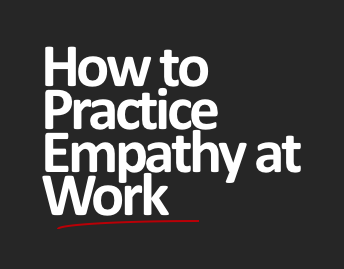How to Practice Empathy at Work
/Some people are naturally more empathic than others
Generally, we begin to develop our empathic skills when we are children by observing and learning from our family, communities, coaches, mentors, teachers and entertainment. When we mirror these behaviours we are rewarded (often with praise and attention) which further locks our understanding and comfort exhibiting these behaviours. During this process we usually also gain an ability to recognize empathic behaviours in others. The same goes when we practice empathy at work. When we are rewarded we repeat behaviours – both good and bad. So, in order to practice empathy at work we have to have leaders, coworkers and even suppliers and customers who demonstrate empathy and we all (or at least most of us) have to reward each other when we recognize it.
Why Do We Struggle Accessing Empathy?
To experience empathy we have to get in touch with our emotions. It is natural our empathy may be underdeveloped if our awareness, understanding and practice of empathy has not been nurtured. In more extreme cases, some people suffer from Empathy Deficit Disorder (EDD), but for most of us we all have some level of empathy. Some of us are more empathetic than others and many of us have learned to me more empathetic or less empathetic in certain situations, like at work.
There are many reasons why we may struggle accessing empathy. Here are eight:
We may learn to not feel empathy for survival. Imagine a hostile family setting or workspace that we can’t leave because of financial reasons. Knowingly or not, we may learn to not feel based for survival. Unfortunately, shutting down in one space often impacts all the other spaces we exist.
People who have an empathy impairment may be antisocial or have a narcissistic personality, autism or schizophrenia. Another reason people demonstrate low levels of empathy is that they may have been raised in families that avoided their feelings and even condemned others for feeling emotions. Some people have learned to shut down their feelings early in their lives to such a degree that they can’t even recognize or name their own feelings, and if we can’t recognize our own feelings we certainly can’t feel empathy for what other people are feeling, needing or experiencing.
Whatever the reason, people who lack empathy are often disconnected from themselves and the people around them. They may not even aware of their disconnect and that something important is missing. In most cases these people need professional support to learn to connect with their emotions.
Some businesspeople may wrongly have learned that empathy makes them weak or has no place in business / at work.
In our personal lives some people may push away empathy and vulnerability in relationships in order to protect themselves because they have been hurt in the past.
Some people may believe that if the empathize with someone that means they agree. (It does not).
Some people may have learned that showing empathy means they are weak.
Some people avoid empathy so that they can avoid dealing with their own fears and emotions that may cause them pain. Truth is, it is likely that those unprocessed feelings are causing them pain anyway. Again, the best way to learn to safely connect with their emotions is to get professional support.
Some people may believe empathy also means we share an unhealthy or inappropriate intimacy.
Empathy Is A Teachable Skill. How We Can Build And Practice Empathy At Work
Yes, we can learn to be more empathetic over time. This change process is called Neuro plasticity – the creation of new brain patterns. Neuro plasticity is like a reset – the more we change practice the more new habits become new reflexes. And, as I mentioned earlier, in the most difficult cases the best way to learn to safely connect with emotions will likely mean getting professional support.
The same way that great leaders become great by studying leadership techniques, learning and practicing, same goes for empathy. In most adult cases, learning to cultivate empathy and create new brain patterns is possible only when the individual is willing to change. We should also recognize that while supportive people and environments help us cultivate our empathy, angry and disconnected people and environments can weaken our ability to access our own empathy.
As A Leader… Helping Your Team or Team Member Practice Empathy At Work
As a leader I recommend the following two-step approach to helping your team or a member of your team be more empathetic.
Step 1.
The approach to teaching empathy often is customized depending on the person’s motivation and personal style and their environment / culture. In all circumstances, appreciation, positive rewards and recognition are also strongly encouraged as a core element to help individuals feel good about the empathetic choices they are making.
Whether in a personal or business space steps all related to manage each other’s expectations:
Share with them what behaviours are expected and not expected. Whether it is a technical skill or a soft skill, people can’t do what you expect if they don’t know what you expect.
Share why the behaviours that are expected and why they are important to the family and/or company as well as themselves. We all have greater motivation when we know the benefit (the why) our efforts are important and how we are making a difference.
Begin with empathy experiences that will resonate with their own goals and personal motivators. For example, if they are motivated by being seen as an expert in an area or by knowing they have contributed / added to a project, point out how you demonstrate empathy as a reward.
Be careful with what is considered ‘constructive feedback’. In time this will be a useful tool, but in the early stages it may feel demotivating. Instead, in the early stages focus far more on progress made while still acknowledging room for further development. Once individuals experienced success and gained some confidence in the process and their ability… and trust you, constructive feedback can be included. It may also be helpful to use a hypothetical example of how to demonstrate empathy when someone is falling short of expectations. This may provide some clarity without having to impact potential fears until their confidence or trust improves.
Step 2.
Learn to use / deepen your empathy. Your brain has neuroplasticity, it changes based on you repeating actions and / or though patterns and eventually they become routine, easy to access or easy to do. To learn how to be more empathetic, use your body to help your mind.
Listen with empathy. Put yourself in their shoes. Imagine what it would be like to have experienced what they are experiencing… or perhaps remember a time when you have felt like they feel… even if the circumstances are different.
Listen more than you talk – listen attentively. Don’t think about what you will say.
Ask open ended questions like “Tell me more”
Notice how you are feeling – the first step in self-regulating. The second step is to ask “Is what I’m feeling helpful? How do I want to respond? Should I respond? What will be helpful? Will being quiet be what they really need now?
Imagine how they might be feeling. Name the feelings. “They are angry”, “They are feeling they don’t matter” etc.
Discuss how you would feel if you felt that. Would you be motivated or demotivated? What would you do in the short and long term
Discuss the feelings they might be having. Would they be motivated or demotivated? How might they act in the short and long term.
Afterwards, explore what you learned about yourself and about them. Where did you empathize? How did it go? What went well? What might you do a bit differently next time?
As An Individual… Helping Yourself Practice Empathy At Work
If you are trying to help yourself fine-tune your empathy, I have a few recommendations to help you become more empathetic.
Do not try to change everything all at once. One of the first steps in this process is recognition of feelings and emotions within ourselves.
Don’t start on something that is going to be most difficult for you to change.
Do try to change something that is going to have meaningful, noticeable impact so you can feel a win, those around you can notice your effort and change and your efforts will make a difference.
Example: Perhaps start with offering greater recognition and being a mindful listener, but when it comes to having difficult conversations, bring support to those discussions. See growth as one step at a time and that eventually you will be prepared to handle difficult conversations on your own.
Conclusion
The more experiences we have feeling and learning about emotions – especially as youngsters, the more capable at managing our own emotions and being able to correctly recognize and relate to those emotions in other. As adults it can be a longer process but learning how to be more empathetic starts with recognizing the need and practicing empathy.
Let me leave you with one quick discussion of what not to do if you want to be more empathetic.
Don’t invalidate other persons feelings.
Don’t tell others how they should or should not feel (You shouldn’t think that, you should be grateful).
Don’t one-up them, “I know how you feel” or “You think that is big, listen to what happened to me”.
Thank you for reading about how to practice empathy at work.
About Bruce and Bruce Mayhew Consulting.
Bruce is Corporate Trainer, Keynote Speaker and Executive Coach.
Bruce Mayhew Consulting specializes in customized Difficult Conversations, Crucial Conversations or Conflict Management Training, Email Etiquette Training, Leadership & New Leadership Development, Generational Differences, Time Management Training and other soft skills training solutions in Toronto and across Canada. Bruce is also an Executive Coach to a few select clients.
Bruce is an experienced motivational speaker in Toronto and has inspired audiences across Canada and within the USA and the UK. Bruce works hard to always make sure your training event, conference, retreat, or annual general meeting is a success.



